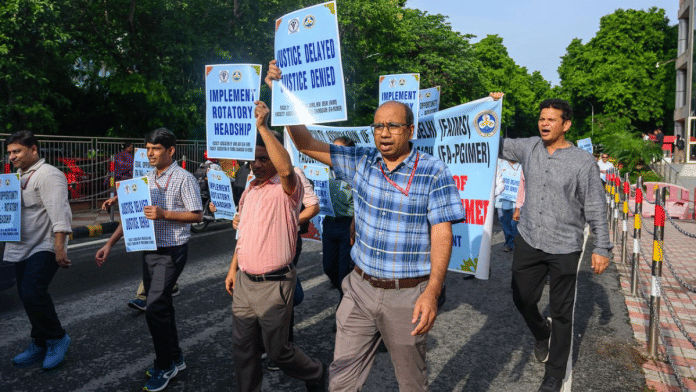New Delhi: Faculty members from two top government medical institutions— the All India Institute of Medical Sciences (AIIMS), New Delhi, and the Postgraduate Institute of Medical Education and Research (PGIMER), Chandigarh—have issued an August 15 deadline for the government to implement a long-promised rotatory headship policy.
The faculty held a peaceful protest at AIIMS Delhi on Friday to seek the implementation of the policy proposing a fixed term for Heads of Department (HoDs), a move aimed at ensuring transparency and equal opportunity in academic leadership.
Holding placards, they warned they would escalate the protest if their demands were not met. Doctors say the current system limits growth opportunities and drives doctors to the private sector, and ultimately hurts patient care
“Even the prime minister has a fixed tenure of five years,” said Dr Shamim Ahmed, professor of nuclear medicine at AIIMS. “At institutions like AIIMS and PGIMER, HoDs often remain in charge for 15 to 20 years, which limits the emergence of new ideas and leadership.”
The rotatory headship proposal caps HoD terms at three years, extendable by another term or until the age of 62, whichever comes first. Appointments would be made by a seven-member Standing Selection Committee, with a provision for early removal in case of underperformance.
Faculty associations have long advocated this system to prevent stagnation and reduce centralisation of power in academic institutions. Faculty argue that without rotation, the same individuals continue in leadership roles for decades, restricting opportunities for others and potentially stifling innovation and institutional growth.
AIIMS Delhi currently has 52 departments, with approximately 30 percent of HoDs in their positions for over 10 years, and more than half serving for over five years. Fewer than 20 of these HoDs are women.
This year’s protest was part of a series of demonstrations under banners such as Hunger for Justice, Relay for Change, and symbolic black badge campaigns. On Doctors’ Day, faculty and residents wore black T-shirts and observed a relay hunger strike.
The protesting doctors had initially planned to march towards Parliament, but did not get permission.
After Friday’s protest, AIIMS director Dr M. Srinivas invited representatives of the Faculty Association of AIIMS (FAIMS) for a dialogue. During the meeting, the administration assured them that steps would be taken toward a positive and time-bound resolution.
Also Read: Bitter pill: Pharmacists upset over Delhi govt’s advisory making CCTV cameras ‘mandatory’
Policy recommendations
The rotary headship policy was first recommended in 2006 by a central government panel. A high-level committee chaired by NITI Aayog’s Dr V.K. Paul, along with former AIIMS director Dr M.C. Mishra and cardiologist Dr K.K. Talwar, was constituted in 2023 to oversee the rollout of rotatory headship at AIIMS and PGIMER.
In 2009, this demand for rotatory headship was first raised with the Ministry of Health during United Progressive Alliance-2, under the then Health Minister Ghulam Nabi Azad.
In July 2023, the Ministry of Health and Family Welfare issued an official order calling for the implementation of the system by June or July 2024.
“It has been decided by the Competent Authority that as far as the implementation of rotation of headship scheme is concerned, collegium system may be implemented for now and after one year, with the approval of the Ministry of Health & Family Welfare, implementation of rotation of headship will be considered/finalised,” the order stated.
Several leading institutions—such as the Institute of Medical Sciences, Banaras Hindu University; the National Institute of Mental Health and Neurosciences, Bengaluru; Jawaharlal Institute of Postgraduate Medical Education and Research, Puducherry; Christian Medical College, Vellore; and Delhi’s Safdarjung Hospital, Dr RML Hospital, and Lady Hardinge Medical College—have adopted a three-year rotational system for HoDs.
However, many others have not yet implemented the policy.
Personal growth & patient care
Dr Karan Juneja, national convenor of IMA’s Junior Doctors Network, pointed to a worrying trend: the exodus of talented young professionals from government institutions to the private sector or abroad.
“During our residency, many doctors choose to leave faculty jobs in government hospitals,” Dr Juneja told ThePrint. “They go on to start their own clinics or join private hospitals, because they feel they’ll never get equal opportunities in public institutions.”
He said many doctors were attracted to private practice as they felt it gave them a sense of autonomy and freed them from rigid hierarchies. “If I know my senior will become HoD at 50 and continue till 60, then what’s the point of waiting around? I’ll be 49 by then, my whole career will be over,” Juneja said.
Many junior doctors see no room for growth under the current system.
Doctors say the push for rotatory headship goes beyond personal ambition. It’s also about creating a healthier institutional environment that ultimately benefits patients.
“It will definitely help patients if doctors are working in a congenial environment, where they can perform to their full potential,” said Dr Sana Hussain, assistant professor in the Department of Anesthesiology and Critical Care.
She argued that talent should not be stifled and leadership should not be concentrated in one individual for decades.
“It’s not just the Head of Department who sees the 10,000 patients that walk into our OPDs every day,” she added. “It is every doctor, resident, faculty, male, female, who contributes to patient care.”
If these professionals are not allowed the space to grow and lead, she warned, the patients who ultimately suffer.
Dr Hussain clarified that the demand for rotatory headship is not driven by personal aspirations. “Everyone sitting here is not doing so because they expect to become HoD. I may not become HoD; I don’t even know what will happen 20 years from now,” she said.
The larger goal, she emphasised, is the growth of the institution and the improvement of patient care.
(Edited by Sugita Katyal)
Also Read: Are Homeopaths, Ayurvedic practitioners doctors? Grandmaster’s spat with ‘Liver Doc’ revives debate






